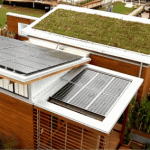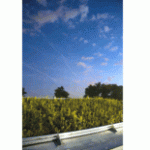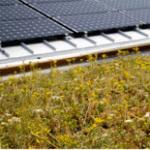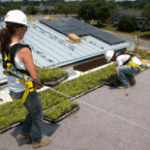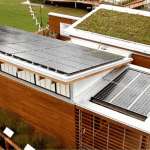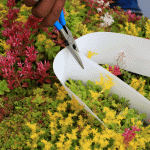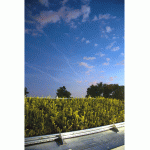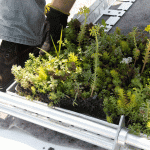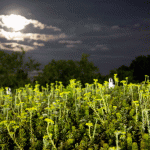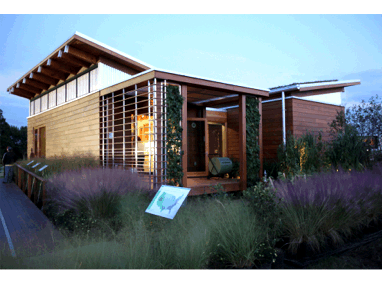
Additional Resources
WaterShed, the University of Maryland’s U.S. Department of Energy?s Solar Decathlon 2011 entry, hosted over 20,000 visitors at the National Mall in West Potomac Park, Washington, D.C. from September 23, 2011 ? October 2, 2011. WaterShed has not yet been set in its permanent location so it is unavailable for visits at this time – but eventually will be again.
See the “WaterShed Digital Walkthrough” video on YouTube here. Find out more about WaterShed and the U.S. Department of Energy Solar Decathlon 2011 at the University of Maryland website. To see photos from the competition, visit the U.S. Department of Energy Solar Decathlon photo page. Learn about the following companies in The Greenroof Directory: LiveRoof, and Tremco, Inc.
WaterShed House, the prototype solar house entry from the team at the University of Maryland, won the U.S. Department of Energy 2011 Solar Decathlon. The U.S. Department of Energy Solar Decathlon is an award-winning program that challenges collegiate teams to design, build, and operate solar-powered houses that are cost-effective, energy-efficient, and attractive. The winner of the competition is the team that best blends affordability, consumer appeal, and design excellence with optimal energy production and maximum efficiency.
“WaterShed is the result of collaborative efforts involving over 200 students from diverse disciplines across the University of Maryland campus, including architecture, engineering, environmental science and technology, plant sciences, landscape architecture, and numerous others. This interactive program provides students with an understanding of the process by which architects, engineers, and other allied professionals engage one another to make a design a constructed reality. This innovative and challenging educational model is guided by a team of faculty members and mentors from the building industries,” WaterShed at the University of Maryland Team Page.
WaterShed is a solar-powered home inspired and guided by the Chesapeake Bay ecosystem, interconnecting the house with its landscape to promote sustainability and ecosystem protection. Two rectangular modules form the house. It is capped by a split-butterfly roof, which is well suited to capturing and using sunlight and rainwater.
Minimizing the impact of the house on water quality in the Chesapeake Bay was a primary design goal. Accordingly, key features of the WaterShed House include: (1) a green roof to retain stormwater and reduce the volume and velocity of run-off and (2) constructed wetlands to filter stormwater and grey water for reuse. The south module of WaterShed House has an extensive green roof with a 10 degree slope covering 312 square feet. The team selected the LiveRoof? Hybrid Green Roof System with LiveRoof Lite modules (1? x 2? x 1 7/8? with 2.5 inches of planting media). The University of Maryland considered several factors in choosing LiveRoof: (1) module design; (2) weight; (3) ease of installation; (4) pre-vegetation; and (5) plant variety.
LiveRoof modules feature the company?s Soil Elevator? and Moisture Portal?, horticultural innovations that establish a green roof as a cohesive ecosystem. The Soil Elevator, a removable insert, lines the inside of modules so soil can be filled above the top. The Moisture Portal? is a curved opening on the sides of the modules and establishes soil-to-soil contact between them. ?When the modules are installed side-by-side, and the Soil Elevators are removed, an uninterrupted layer of soil and vegetation extends across the entire rooftop and conceals the modules beneath,? said Scott Tjaden, environmental sciences student at the University of Maryland and a WaterShed House team member.
The LiveRoof design unifies the entire installation into a naturally functioning biological system. Natural function maximizes plant health, long-term sustainability, rooftop aesthetics, roof membrane protection, and environmental benefits. Fully vegetated and saturated, the weight of LiveRoof Lite modules (about 15-17 pounds per square foot) is less than Maryland?s average snow load. Thus, the team demonstrated that a green roof can be practical without any special structural roof requirements. ?Ease of installation was important,? said Tjaden. ?Our team was able to disassemble, transport, and re-install the green roof on-site for the Decathlon competition without any specialized, heavy machinery.?
Most modular systems are planted with only plant plugs and take two or three years to fill in. The University of Maryland team needed an instant green roof for the competition. Riverbend Nursery, a LiveRoof licensed regional grower and distributor, delivered the system from nearby Virginia to the University of Maryland with modules fully vegetated with regionally adapted, locally grown plants that were already mature and flourishing. Riverbend offered a wide variety of green roof plants. All 156 LiveRoof Lite modules were planted with a Sedum mix selected specifically for the WaterShed House. Six species of sedums are featured on the green roof: Sedum album “Coral Carpet,” S. spurium “Dragon’s Blood,” S. reflexum “Blue Spruce,” S. spurium “tricolor,” S. reflexum “Angelina,” and S. sexangular “Utah.”
 Greenroofs.comConnecting the Planet + Living Architecture
Greenroofs.comConnecting the Planet + Living Architecture
